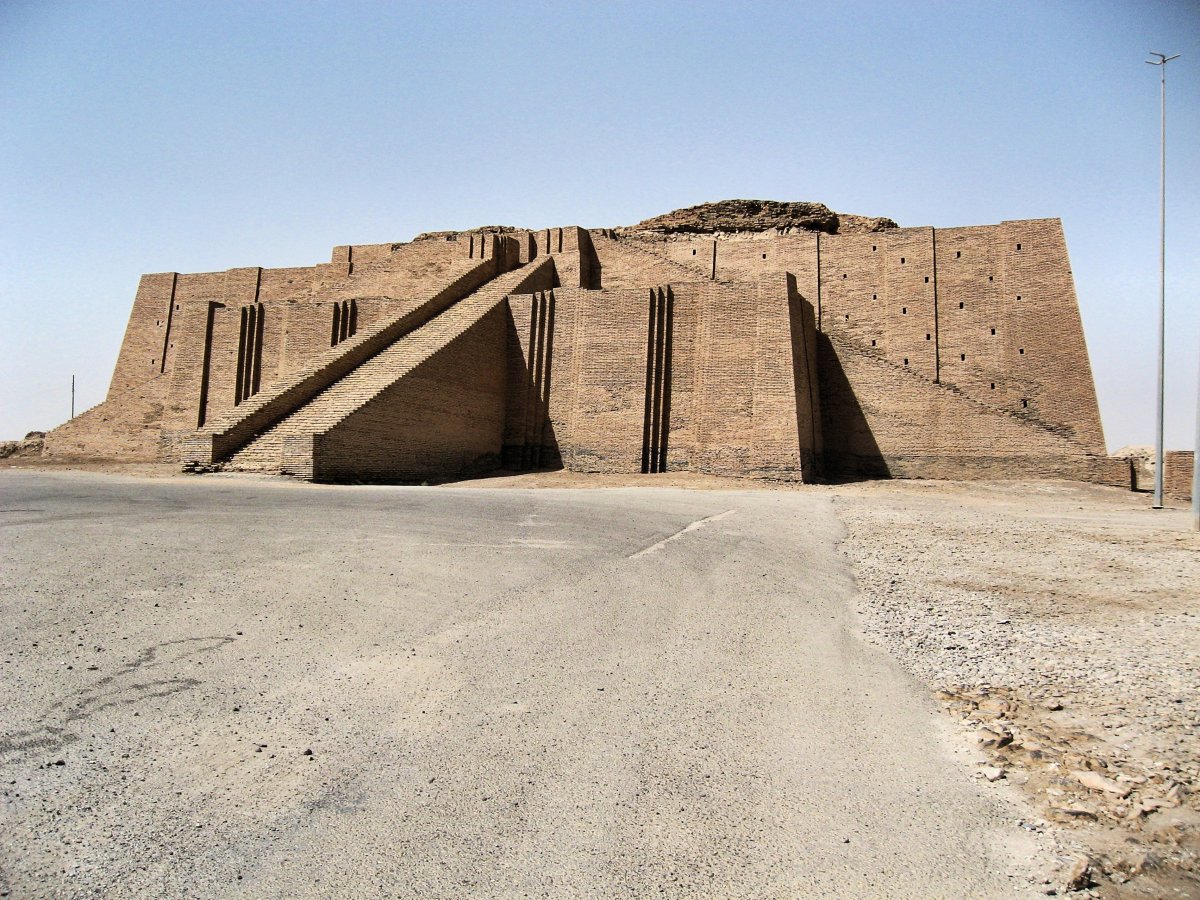It has been nearly two decades since the U.S. invaded Iraq in 2003. But theories into the U.S' rationale behind the invasion continue to spread.
Since the invasion, many hypotheses have been floated, from the official line about preventing the proliferation of weapons of mass destruction, to others by the war's critics that involve oil and geopolitical interests.
The complexity behind the rationale for the U.S. military operation has also triggered a variety of conspiracy theories.

The Claim
One such conspiracy theory has resurfaced recently on a Reddit post. The post, located in the conspiracy community on the platform, shows a picture of Iraq's historical landmark, the Great Ziggurat of Ur.
"This is the real reason we invaded Iraq. Ancient alien Stargate portal located in the Great Ziggurat of Ur in Iraq," Reddit user PalatableMahogany said in a caption.
The Reddit post has received 1.7k upvotes on the platform. Many other Redditors took to the comment section to debate the claim.
"Wow, I never bothered to look it up. But yes, this makes sense. Get 2 birds stoned at once," one Reddit user said.
Others were not so sure the theory made sense.
"Pics of the Stargate or it didn't happen," another Reddit user said.
Another Reddit user said: "And all that time I thought it was oil and gold...But, yeah, the Stargate. Makes sense."
The Facts
The Great Ziggurat of Ur is an ancient structure that used to be at the center of Mesopotamia, a historical region in western Asia. The Ziggurat was originally built during the Early Bronze Age and reconstructed in the 6th century.
Today, it stands remarkably well preserved, in a remote pit of desert in Iraq's Dhi Qar Province, according to the Madain Project, an online archive of Abrahamic History and Archaeology.
Often dubbed "Iraq's answer to the pyramids," the structure (and others like it) typically had several terraced levels as opposed to the pyramids' flat walls, but didn't have interior chambers.
It originally stood between 70 and 100 feet high, according to the art history resource, Smarthistory.
Mesopotamia used to be home to the Sumerians, which was one of the first civilizations to exist, dating back to 3,000 BC. The civilization worshiped a group of deities called Anunnaki, according to The Oxford Companion to World Mythology written by David Leemings.
This may be the nugget of truth in the "stargate" narrative, with conspiracy theorists believing that the Anunnaki were actually extraterrestrials that gifted 'Stargate' portals to the people living at the time, a 2017 VICE article reported.
Stargate portals are hypothetical devices, often depicted in science fiction, that allow for rapid travel from one distant location to the other, and social media users purported that one of these stargates is located in the Great Ziggurat of Ur.
However, there is no scientific evidence to back up the claim that an alien stargate is located in the Great Ziggurat of Ur, built around 2100 B.C.E. by the king Ur-Nammu of the Third Dynasty of Ur, less so that it was a factor in the U.S.' invasion of Iraq.
The location was initially used by Iraqi leader Saddam Hussein's forces as a military facility, the Tallil Air Base, which was largely destroyed by the American forces in 1991, according to U.S. military records. Then, in 2003, the U.S. retook it, and the Pentagon closed public access to the land adjacent to the structure, after building a new airfield and military base there, as Fox News reported in 2009.
While the move did restrict public access to the area, as the Fox News and other reports at the time noted, it remained open to U.S. military personnel stationed in the area, turning the location into something of a tourist hot spot for American troops.
This was a source of much frustration for Iraqi citizens, who were not allowed to enter the holy site, especially amid reports, including by the Guardian, citing local aid workers, about cases of vandalism targeting the ancient structure. These incidents, the report noted, resulted in the Ziggurat being briefly declared off limits to U.S. troops as well.
The Pentagon eventually handed control over the archaeological landmark back to the Iraqi government in May 2009, according to the U.S. military records, removing its location outside the official bounds of the base.
The air base itself was held by U.S. forces, as well as variably by Australian and Romanian troops, until America's full withdrawal in December 2011, at which point the Pentagon handed control of it back to Iraq, as part of the New Dawn operation.
As for the much more complex and controversial wider topic—the rationale behind the Iraq war—many reasons have been floated. But the general consensus, as stated by the Council on Foreign Relations and historians, remains that the main, if not isolated reason, was to end the regime of Saddam Hussein.
The U.S. justified the invasion by claiming that Iraq was hiding weapons of mass destruction and thus posing a major security threat.
But while Iraq possessed such weapons during the Iran-Iraq War of 1980 to 1988, they no longer did in 2003 at the time of the war.
What we know for sure is that the U.S has always had "long-standing geopolitical interests in the Greater Middle East," Jason Opal, Professor of History at McGill University told Newsweek.
"Some of which they inherited from prior imperial powers such as Britain and France," Opal said.
"These interests are mostly, although not entirely about access to oil—not just in terms of securing that oil for US consumers and corporations, but also in denying that same oil from enemy nations, such as Russia and China.
"Especially after his invasion of Kuwait on August 2, 1990, Saddam Hussein—formerly a US ally against Iran—became a major threat to these interests, and his general brutality and unpredictability made him unacceptable to many US leaders."
Until 2001, the U.S. resolved to contain and isolate Hussein, but the events of 9/11 gave President George W. Bush a pretext to "replace him with force," Opal said.
"The evidence indicates that the Bush administration severely stressed the evidence of Hussein's terrorist ties and nuclear program, selling the war to the US public on exaggerated claims if not outright lies," Opal said.
"But there is absolutely no reason to imagine any other hidden motives. Their purpose was to destroy Hussein's regime, implant a US-friendly government, and promote US (and, by extension, Israeli) dominance over the region. Period, full stop.
"There are plenty of reasons to be skeptical about the Bush administration's stated and actual reasons for launching that war. But there are also plenty of ways to explain the underlying reasons without falling into fact-free conspiracy theory."
The Ruling

False.
While the concrete reason for the Iraq war remains a subject of debate, the claim that an alien stargate triggered the invasion is false on multiple levels.
Several genuine factors, including geopolitical and economic ones, form the basis of historians' consensus on the Bush administration's motives.
The Ziggurat of Ur is an ancient structure, among several ziggurats still standing, that was built by ancient Mesopotamians and has since been reconstructed twice, in antiquity and again in the 1980s, but there is no scientific basis for claims that it is, or plays host to, an alien stargate.
While it was indeed under U.S. control for some time (due to its location adjacent to an existing air base taken over by the Americans), it was handed back to the Iraqi government shortly before the full withdrawal of U.S. troops from the country.
FACT CHECK BY NEWSWEEK
Uncommon Knowledge
Newsweek is committed to challenging conventional wisdom and finding connections in the search for common ground.
Newsweek is committed to challenging conventional wisdom and finding connections in the search for common ground.
About the writer
Robyn White is a Newsweek Nature Reporter based in London, UK. Her focus is reporting on wildlife, science and the ... Read more
To read how Newsweek uses AI as a newsroom tool, Click here.








